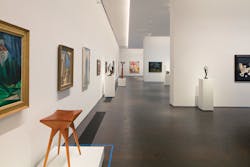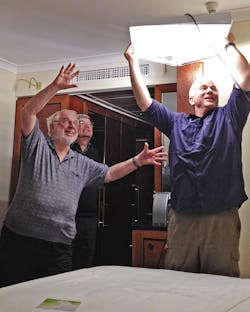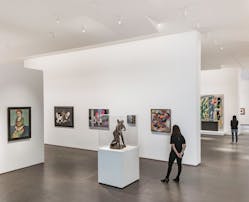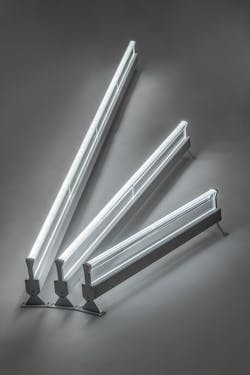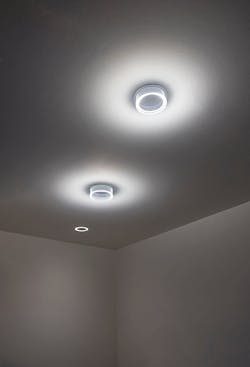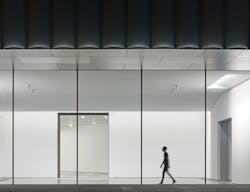Based in Las Vegas, QuarkStar technically may be considered a startup, but its employee roster reads like a list of lighting and technology industry superstars. Perhaps not surprisingly, the alma maters of the staff — led by CEO Louis Lerman, chief financial officer Sara Kuwabara, and chief operations officer Jacqueline Teng — rival any international ranking of higher-education institutions and include Stanford University; University of California, Berkeley; University of California, Los Angeles; Massachusetts Institute of Technology; Rice University; Tulane University; and several technical universities in Germany.
Early contributors to QuarkStar technologies included pioneers of solid-state lighting such as Roland Haitz of Haitz’s Law; Bob Steele, Strategies in Light; and Peter Stormberg, former CTO of Philips Lighting. Along with their protégés from the field of SSL, they teamed with experts in controls; AI, robotics, and aerospace; building and land development; and medicine to create QuarkStar, a 2022 winner in the Department of Energy’s L-Prize Phase 1.
The firm shared with LEDs Magazine its ingredients for success and innovation.
Firm mission: Solid-state lighting faces significant obstacles to realizing its potential. As SSL’s first deep-tech skunk works, QuarkStar seeks to develop real-world solutions that overcome current compromises on light quality, size, efficiency, and controls. Our mission: No more compromises, do more with less, and, above all, create light that people will love.
What we are known for: Edge-X, which was the first of QuarkStar’s LED technologies to hit the market. Its modular optical system enables it to herd nearly every photon emitted from an LED and guide it to only where needed. With its compact footprint, meticulously mixed and conditioned light, and ability to switch distributions by swapping a 1-in. optic, Edge-X exemplifies doing more with less.
Most of our innovations are based on two principles: "A photon is a terrible thing to waste!" as Roland Haitz would say; and "Light is only useful if it's where it needs to be. Control is key!"
What people don’t know about us: Many team members are well known to the industry, but their diversity in backgrounds and interests are less so. Most, if not all, our team members are polymaths; we have several trained musicians and artists with published works in various mediums. Half of our executive team members are women and 60% of the inventors behind our IP portfolio (300 issued patents to date) are STEM minority members.
This mix of perspectives, knowledge bases, and real-world experience directly contributes to our creativity. In the past seven years, QuarkStar has averaged one new patent filing a week and received one newly issued or allowed patent every two weeks. All this from our 10-person technical team.
First project: We provided the primary gallery lighting for the Museum of Fine Arts Houston’s new Kinder Building, the largest U.S. fine arts building development at the time (2020). With 16-ft-tall gallery walls and an architectural theme of “porosity” between the indoors and out, the project was the ideal proving ground for our Q-Wall asymmetric linear fixture based on Edge-X. Q-Wall uniformly illuminates Kinder Building’s expansive walls with perfectly mixed light from a narrow optic; the museum even decided to redesign its coves to leverage this unexpected extra space. Edge-X integrates seamlessly into the built environment while creating an experience nearly indistinguishable from standing near a window or under a skylight.
It was a key demonstration of our mission to do more with less, delivering an experience that can meld harmoniously with the architect's vision of bringing the outdoors in, without having to compromise between lighting quality, size, or system efficiency.
Our favorite product: The U.S. Department of Energy’s L-Prize (Phase 1) challenge let us showcase our larger vision: a truly integrated solution for SSL technologies that encompasses multiple levels of luminaire systems, from LED packages to optics to systems control. This was the culmination of multiple suites of technologies QuarkStar had developed under a new division focused on creating the solutions of the future: Photon Works.
Our winning fixture design integrates technology suites we have developed at all these levels — novel package architecture, our Edge-X optics, and a networked control system based on OpenThread. With our L-Prize partner Nichia, we met DOE’s stretch goals for color and quality and for efficacy, color rendition, lighting distribution, and environmental considerations.
We did not compromise or make trade-offs. All technologies can be manufactured with today’s methods, with most having already demonstrated real-world success.
Current projects: We’re working on linear high-aspect-ratio sources, which have fantastic advantages in translating the “infinite” luminosity of pointlike LEDs to optimal real-world use. Examples include the Edge-X virtual filament; surface-mounted filaments for the L-Prize concept; and linear light strips of unpackaged dies for all lamp types.
Our firm culture: QuarkStar brings together multidisciplinary experts to brainstorm how we can consistently break the mold in SSL. Even before COVID-19, we supported a flexible work style that welcomed inspiration from all areas of life — even, or especially, from our children and pets. We create the light we want for our families, our friends, and ourselves.
Lighting trend to leave behind: The focus on lm/W for rating fixtures and, by extension, the disregard for conservation of étendue. If a product has high lm/W, but only 50% of those lumens are hitting the target, then 50% of the lumens are being wasted. A more useful metric would be light-on-target: How many lumens are on target and, thus, not contributing to light trespass?
Preserving étendue and the proper shaping of light is key to delivering useful, beautiful light without compromising efficiency or efficacy. In fact, they can and should work together.
Tool or product you want to invent: We've invented it. Now we're at the fun part of finding collaborators to bring it all to market.
Advice to anyone interested in entering the lighting industry: Practically speaking, join the Illuminating Engineering Society — it’s a great resource for people at all experience levels. But most importantly, go out into nature and observe natural light. Go at different times of day. Experience it in different atmospheric conditions, seasons, and latitudes. Current lighting technologies have outstripped what is needed for “functional” lighting. Now is the time to pursue the type of lighting with which humans have evolved over millions of years.
Designer you admire: DaVinci, Turner, and Monet were each an explorer of light who invented a new way of capturing and recreating the luminosity of natural light, but also the beauty and emotion of the moment.
This is QuarkStar’s aspiration: to recreate nature’s luminous best and the emotion that comes from experiencing it.
Favorite lighting or engineering rule of thumb: Lerman’s Law of Technology: Any technical problem can be overcome given enough time and money. Lerman's Corollary: You are never given enough time or money.
WANDA LAU is editorial director of LEDs Magazine and Smart Buildings Technology. She previously served as executive editor of Architect magazine and worked for a decade in the architecture, engineering, and construction industry.
For up-to-the-minute LED and SSL updates, follow us on Twitter. You’ll find curated content and commentary, as well as information on industry events, webcasts, and surveys on our LinkedIn page and our Facebook page.
